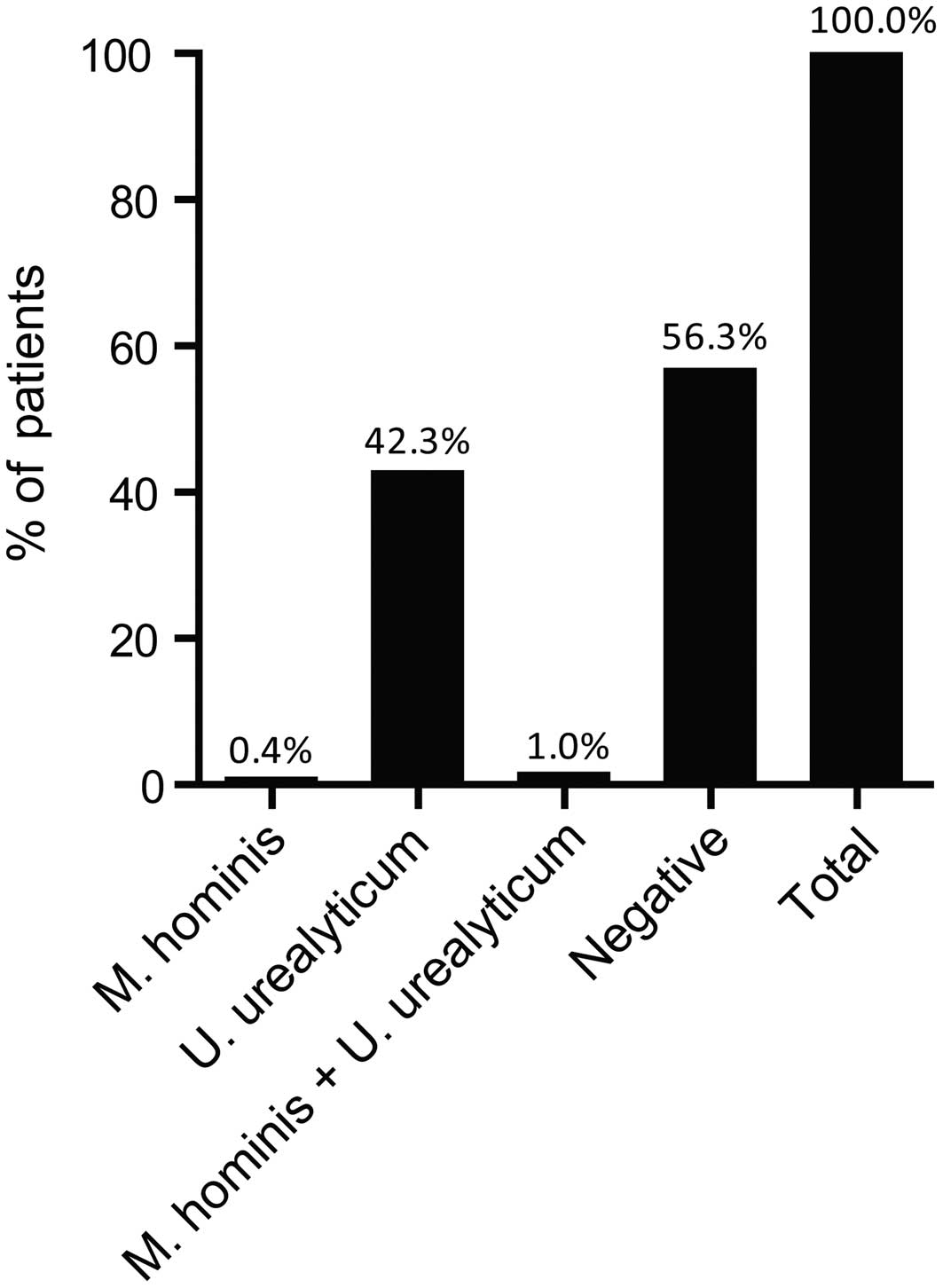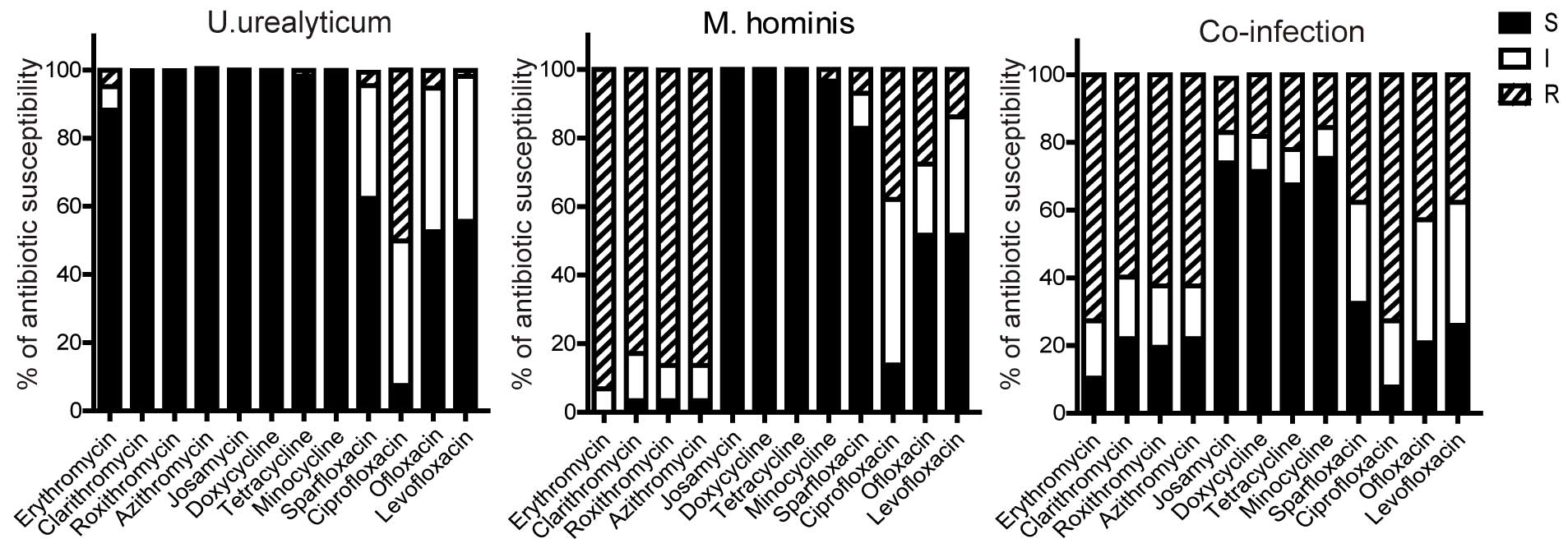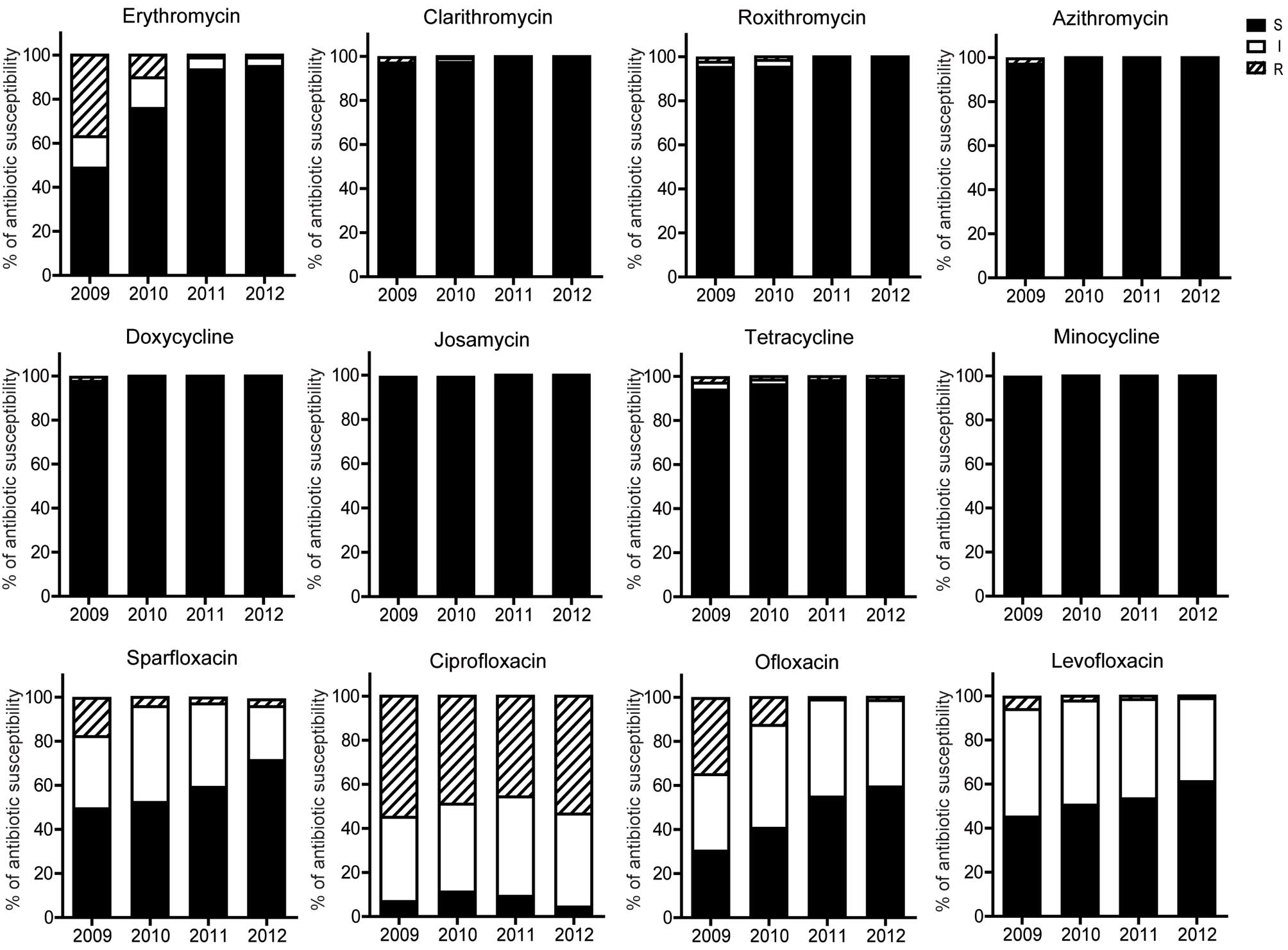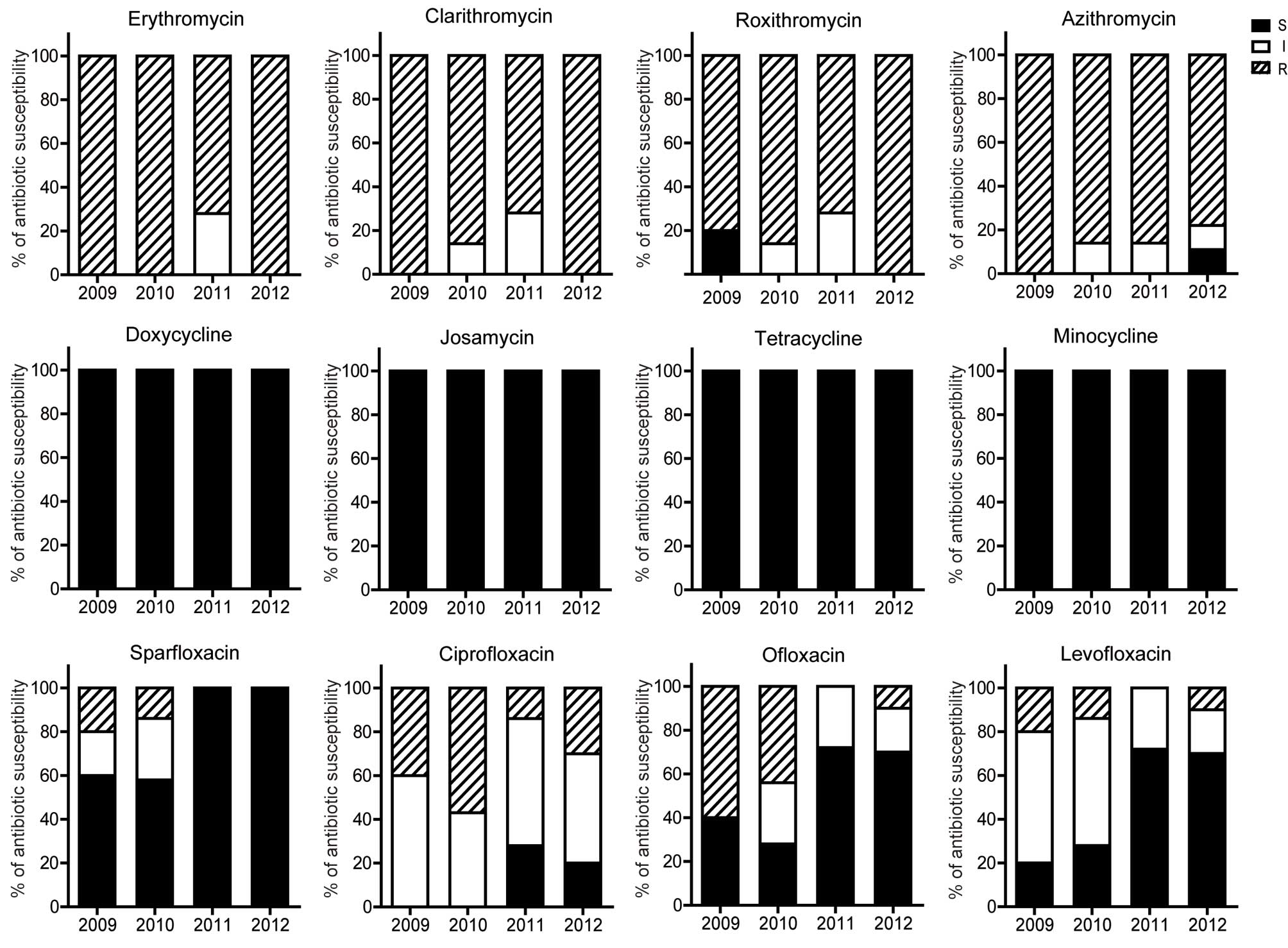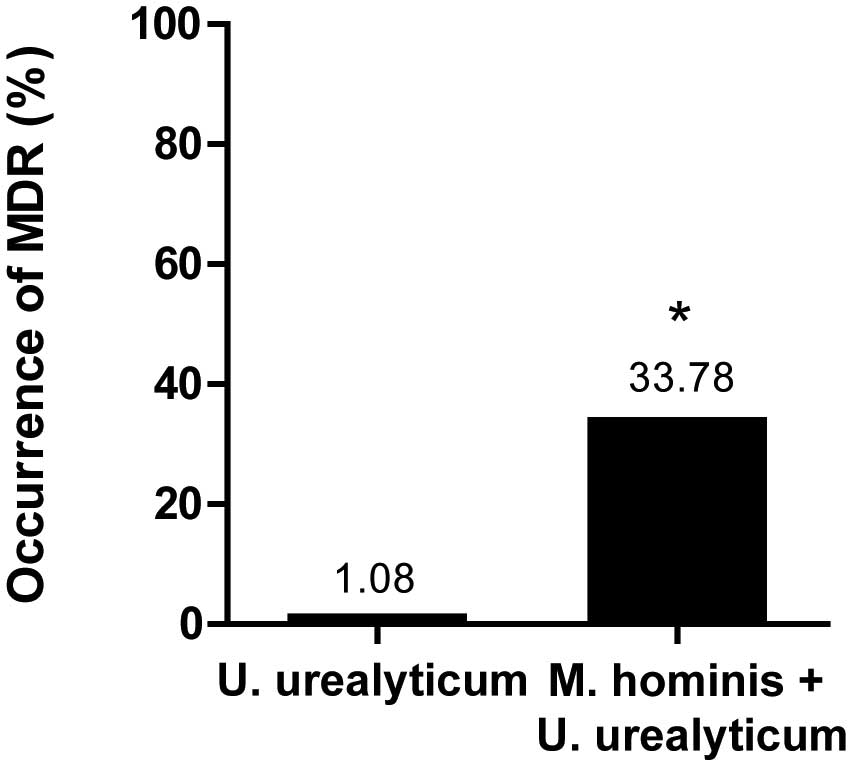|
1
|
Horner P, Blee K and Adams E: Time to
manage Mycoplasma genitalium as an STI: But not with
azithromycin 1 g! Curr Opin Infect Dis. 27:68–74. 2014. View Article : Google Scholar : PubMed/NCBI
|
|
2
|
Citti C and Blanchard A:
Mycoplasmas and their host: Emerging and re-emerging minimal
pathogens. Trends Microbiol. 21:196–203. 2013. View Article : Google Scholar : PubMed/NCBI
|
|
3
|
Waites KB, Katz B and Schelonka RL:
Mycoplasmas and ureaplasmas as neonatal pathogens. Clin Microbiol
Rev. 18:757–789. 2005. View Article : Google Scholar : PubMed/NCBI
|
|
4
|
McCormack WM: Susceptibility of
mycoplasmas to antimicrobial agents: Clinical implications. Clin
Infect Dis. 17(Suppl 1): S200–S201. 1993. View Article : Google Scholar : PubMed/NCBI
|
|
5
|
Furneri PM, Rappazzo G, Musumarra MP, Di
Pietro P, Catania LS and Roccasalva LS: Two new point mutations at
A2062 associated with resistance to 16-membered macrolide
antibiotics in mutant strains of Mycoplasma hominis.
Antimicrob Agents Chemother. 45:2958–2960. 2001. View Article : Google Scholar : PubMed/NCBI
|
|
6
|
Dégrange S, Renaudin H, Charron A, Bébéar
C and Bébéar CM: Tetracycline resistance in Ureaplasma spp.
and Mycoplasma hominis: Prevalence in Bordeaux, France, from
1999 to 2002 and description of two tet (M)-positive isolates of
M. hominis susceptible to tetracyclines. Antimicrob Agents
Chemother. 52:742–744. 2008. View Article : Google Scholar : PubMed/NCBI
|
|
7
|
Pereyre S, Renaudin H, Charron A, Bébéar C
and Bébéar CM: Emergence of a 23S rRNA mutation in Mycoplasma
hominis associated with a loss of the intrinsic resistance to
erythromycin and azithromycin. J Antimicrob Chemother. 57:753–756.
2006. View Article : Google Scholar : PubMed/NCBI
|
|
8
|
Mardassi BB, Aissani N, Moalla I, Dhahri
D, Dridi A and Mlik B: Evidence for the predominance of a single
tet(M) gene sequence type in tetracycline-resistant Ureaplasma
parvum and Mycoplasma hominis isolates from Tunisian
patients. J Med Microbiol. 61:1254–1261. 2012. View Article : Google Scholar : PubMed/NCBI
|
|
9
|
Waites KB, Crabb DM, Bing X and Duffy LB:
In vitro susceptibilities to and bactericidal activities of
garenoxacin (BMS-284756) and other antimicrobial agents against
human Mycoplasmas and Ureaplasmas. Antimicrob Agents
Chemother. 47:161–165. 2003. View Article : Google Scholar : PubMed/NCBI
|
|
10
|
Wang QY, Li RH, Zheng LQ and Shang XH:
Prevalence and antimicrobial susceptibility of Ureaplasma
urealyticum and Mycoplasma hominis in female
outpatients, 2009–2013. J Microbiol Immunol Infect. 2014.[Epub
ahead of print].
|
|
11
|
De Francesco MA, Caracciolo S, Bonfanti C
and Manca N: Incidence and antibiotic susceptibility of
Mycoplasma hominis and Ureaplasma urealyticum
isolated in Brescia, Italy, over 7 years. J Infect Chemother.
19:621–627. 2013. View Article : Google Scholar : PubMed/NCBI
|
|
12
|
Clinical and Laboratory Standards
Institute (CLSI): Methods for antimicrobial susceptibility testing
for human mycoplasmas; Approved guideline. CLSI Document M43-A.
CLSI. (Wayne, PA). 2–5. 2011.
|
|
13
|
Magiorakos AP, Srinivasan A, Carey RB,
Carmeli Y, Falagas ME, Giske CG, Harbarth S, Hindler JF, Kahlmeter
G, Olsson-Liljequist B, et al: Multidrug-resistant, extensively
drug-resistant and pandrug-resistant bacteria: An international
expert proposal for interim standard definitions for acquired
resistance. Clin Microbiol Infect. 18:268–281. 2012. View Article : Google Scholar : PubMed/NCBI
|
|
14
|
Wang YX, You L, Zeng Q, Sun Y, Huang YH,
Wang C, Wang P, Cao WC, Yang P, Li YF and Lu WQ: Phthalate exposure
and human semen quality: Results from an infertility clinic in
China. Environ Res. 142:1–9. 2015. View Article : Google Scholar : PubMed/NCBI
|
|
15
|
Hu W, Chen M, Wu W, Lu J, Zhao D, Pan F,
Lu C, Xia Y, Hu L, Chen D, et al: Gene-gene and gene-environment
interactions on risk of male infertility: Focus on the metabolites.
Environ Int. 91:188–195. 2016. View Article : Google Scholar : PubMed/NCBI
|
|
16
|
Gimenes F, Souza RP, Bento JC, Teixeira
JJ, Maria-Engler SS, Bonini MG and Consolaro ME: Male infertility:
A public health issue caused by sexually transmitted pathogens. Nat
Rev Urol. 11:672–687. 2014. View Article : Google Scholar : PubMed/NCBI
|
|
17
|
Crăcea E, Măicănescu-Georgescu M,
Constantinescu S and Botez D: Genital Mycoplasmas and
Chlamydiae in male infertility. Arch Roum Pathol Exp
Microbiol. 41:219–224. 1982.PubMed/NCBI
|
|
18
|
de Barbeyrac B, Bernet-Poggi C, Fébrer F,
Renaudin H, Dupon M and Bébéar C: Detection of Mycoplasma
pneumoniae and Mycoplasma genitalium in clinical samples
by polymerase chain reaction. Clin Infect Dis. 17(Suppl 1):
S83–S89. 1993. View Article : Google Scholar : PubMed/NCBI
|
|
19
|
Oriel JD: Role of genital mycoplasmas in
nongonococcal urethritis and prostatitis. Sex Transm Dis. 10(Suppl
4): S263–S270. 1983.
|
|
20
|
Al-Sweih NA, Al-Fadli AH, Omu AE and
Rotimi VO: Prevalence of Chlamydia trachomatis,
Mycoplasma hominis, Mycoplasma genitalium and
Ureaplasma urealyticum infections and seminal quality in
infertile and fertile men in Kuwait. J Androl. 33:1323–1329. 2012.
View Article : Google Scholar : PubMed/NCBI
|
|
21
|
Gdoura R, Kchaou W, Chaari C, Znazen A,
Keskes L, Rebai T and Hammami A: Ureaplasma urealyticum,
Ureaplasma parvum, Mycoplasma hominis and
Mycoplasma genitalium infections and semen quality of
infertile men. BMC Infect Dis. 7:1292007. View Article : Google Scholar : PubMed/NCBI
|
|
22
|
Filipiak E, Marchlewska K, Oszukowska E,
Walczak-Jedrzejowska R, Swierczynska-Cieplucha A, Kula K and
Slowikowska-Hilczer J: Presence of aerobic micro-organisms and
their influence on basic semen parameters in infertile men.
Andrologia. 47:826–831. 2015. View Article : Google Scholar : PubMed/NCBI
|
|
23
|
Lee JS, Kim KT, Lee HS, Yang KM, Seo JT
and Choe JH: Concordance of Ureaplasma urealyticum and
Mycoplasma hominis in infertile couples: Impact on semen
parameters. Urology. 81:1219–1224. 2013. View Article : Google Scholar : PubMed/NCBI
|
|
24
|
Abusarah EA, Awwad ZM, Charvalos E and
Shehabi AA: Molecular detection of potential sexually transmitted
pathogens in semen and urine specimens of infertile and fertile
males. Diagn Microbiol Infect Dis. 77:283–286. 2013. View Article : Google Scholar : PubMed/NCBI
|
|
25
|
Salmeri M, Valenti D, La Vignera S,
Bellanca S, Morello A, Toscano MA, Mastrojeni S and Calogero AE:
Prevalence of Ureaplasma urealyticum and Mycoplasma
hominis infection in unselected infertile men. J Chemother.
24:81–86. 2012. View Article : Google Scholar : PubMed/NCBI
|
|
26
|
Taylor-Robinson D and Bébéar C: Antibiotic
susceptibilities of Mycoplasmas and treatment of mycoplasmal
infections. J Antimicrob Chemother. 40:622–630. 1997. View Article : Google Scholar : PubMed/NCBI
|















